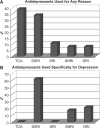Depression in amyotrophic lateral sclerosis
- PMID: 21091399
- PMCID: PMC3155886
- DOI: 10.3109/17482968.2010.536839
Depression in amyotrophic lateral sclerosis
Abstract
Depression is an under-recognized comorbidity associated with amyotrophic lateral sclerosis (ALS). The goals of this study were to prospectively estimate the prevalence of depression and other ALS related symptoms and to study the impact of depression on enrollment in research studies. One hundred and twenty-seven people with ALS completed the ALS Depression Inventory (ADI-12) and answered questions about ALS related symptoms and research study enrollment preferences. Demographics, ALS symptoms, medications, functional status, and research enrollment were compared between depressed and non-depressed patients. Results showed that the prevalence of mild and severe depression was 29% and 6%, respectively. More than one-third of our ALS patients were receiving anti-depressants to treat depression, sialorrhea, and pseudobulbar affect. Depression prevalence was not correlated with disease duration or progression. Except for anxiety, none of the ALS related symptoms predicted depression. The presence of depression did not have an effect on the decision to enroll in research studies. In conclusion, major depression is less common in our ALS cohort than in the general population. The diagnosis of depression can be masked by some ALS related symptoms and it has no impact on enrollment in ALS clinical trials.
Figures


References
-
- Wicks P, Abrahams S, Masi D, Hejda-Forde S, Leigh PN, Goldstein LH. Prevalence of depression in a 12-month consecutive sample of patients with ALS. European Journal of Neurology. 2007;14:993–1001. - PubMed
-
- Hammer EM, Häcker S, Hautzinger M, Meyer TD, Kübler A. Validity of the ALS Depression Inventory (ADI-12): a new screening instrument for depressive disorders in patients with amyotrophic lateral sclerosis. Journal of Affective Disorders. 2008;109:213–9. - PubMed
-
- Tedman BM, Young CA, Williams IR. Assessment of depression in patients with motor neuron disease and other neurologically disabling illness. J Neurol Sci. 1997;152:75–9. - PubMed
-
- Ganzini L, Johnston WS, Hoffman WF. Correlates of suffering in amyotrophic lateral sclerosis. Neurology. 1999;52:1434–40. - PubMed
Publication types
MeSH terms
Substances
Grants and funding
LinkOut - more resources
Full Text Sources
Medical
Miscellaneous
